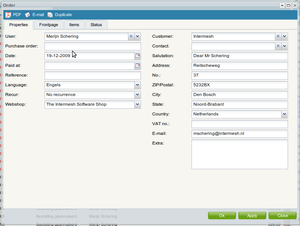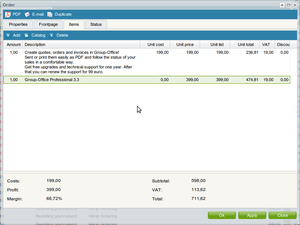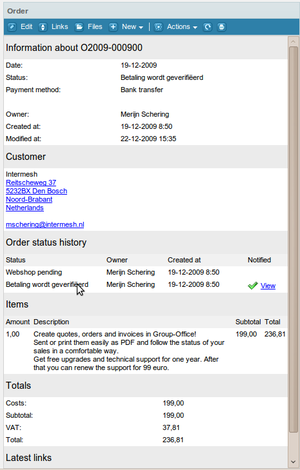| This manual is deprecated. Please visit https://groupoffice.readthedocs.io for the latest documentation. |
Difference between revisions of "Billing"
(→General usage) |
m (→General usage) |
||
| Line 43: | Line 43: | ||
[[Image:Order_edit.png|right|thumb|Edit order information]] | [[Image:Order_edit.png|right|thumb|Edit order information]] | ||
[[Image:Order_items.png|right|thumb|Edit order items]] | [[Image:Order_items.png|right|thumb|Edit order items]] | ||
| − | [[Image: | + | [[Image:Order_info_panel.png|right|thumb|View order information]] |
===Creating an invoice=== | ===Creating an invoice=== | ||
Click on 'Add' to create a new invoice. Type in the company name. The system will search through the addressbook and autocomplete all fields it finds in your addressbook. Now continue to the items tab and fill in products / services. You can also add products from the catalog here. When you are finished you can set a status for it. You can select "Notify customer" and the e-mail and PDF associated with that status will be sent to the customer if an e-mail address is defined in the invoice. You can also sent the mail manually by clicking the 'e-mail' button. | Click on 'Add' to create a new invoice. Type in the company name. The system will search through the addressbook and autocomplete all fields it finds in your addressbook. Now continue to the items tab and fill in products / services. You can also add products from the catalog here. When you are finished you can set a status for it. You can select "Notify customer" and the e-mail and PDF associated with that status will be sent to the customer if an e-mail address is defined in the invoice. You can also sent the mail manually by clicking the 'e-mail' button. | ||
Revision as of 16:55, 22 December 2009
Contents
Setting it up
First you need to setup the books, statuses and templates. Three default books have been created for you. They are called: Invoices, Orders and Quotes. In these books you create items and they can be duplicated to other books. A copy of the original Quote or Order will always remain.
Changing the sequential numbers
By default GO creates a number like Q200900001 for a quote and I200900001 for an invoice. You can change this number at:
Administration -> Books -> Double click book
%y will be substituted by the full 4 digit year. %m will be substituted by the 2 digit month number
Setting up templates and statuses
First you've got to setup PDF and e-mail templates. Templates are linked to order statuses. Each order status has a unique e-mail template and a linked PDF template. When you change an invoice to another status the PDF and outgoing e-mail will change as well to match that status.
When the billing module is installed it creates some default books and templates. To change a PDF template goto:
Billing -> Administration -> Double click the book -> Templates
When you change the logo you should use a logo that is about twice as big as the logo appears on screen. After you uploaded the logo you should divide the detected image size by 2. (Select the logo, click 'Apply', divide the detected values, click 'Ok' or 'Apply' again.
Download an example invoice PDF
To change an e-mail template or to link another PDF template to an order status goto:
Billing -> Administration -> Double click the book -> Statuses
In the e-mail template you can use a number of variables. You can find them at http://www.group-office.com/wiki/Billing_E-mail_template_variables.
Note: If you have problems with characters that don't appear correct please read this page: http://www.group-office.com/wiki/Installation#PDF_fonts
Creating a custom PDF script
Sometimes the default PDF does not suit your needs. In that case you can program your own PDF creator script. All you need to do is copy modules/billing/classes/pdf.class.inc.php and put the path to the new file in config.php like this:
$config['billing_pdf_class']='/any/path/to/mypdf.class.inc.php';
The PDF class is an extended class of the TCPDF class. Read more about it at http://www.tecnick.com/public/code/cp_dpage.php?aiocp_dp=tcpdf
General usage
Creating an invoice
Click on 'Add' to create a new invoice. Type in the company name. The system will search through the addressbook and autocomplete all fields it finds in your addressbook. Now continue to the items tab and fill in products / services. You can also add products from the catalog here. When you are finished you can set a status for it. You can select "Notify customer" and the e-mail and PDF associated with that status will be sent to the customer if an e-mail address is defined in the invoice. You can also sent the mail manually by clicking the 'e-mail' button.
Creating recurring invoices
It's easy to create recurring invoices. Just select the recurrence interval at the 'Properties' tab of an invoice. This will schedule a next invoice at the moment this invoice gets a status assigned. When the next recurrence is ready to be sent it will appear as scheduled in the list. You can send out all scheduled orders at once using the 'Batch jobs'.
Duplicating orders, invoices or quotes
It's easy to duplicate items. It's very useful when you start off with a quote, when this quote is accepted you can duplicate it to an order and finally duplicate that order to an invoice. To do so just select a quote for example and click at Actions -> Duplicate at the right pane. A small dialog pops up that allows you to change the status of the selected item and you can select the book to duplicate the quote to. You can select the status "Quote accepted" for example and duplicate it to the orders book. When you work at this order some things might be added to the order and when the job is done you can repeat the duplication process to create your invoice.
Batch job
With a batch job you can change multiple order statuses at once. It's very useful to send out all scheduled orders or to remind all users about an invoice that hasn't been paid yet. Click on 'Batch jobs' and select a from status and a too status. For example from: None to: Waiting for payment to send out scheduled orders. Optionally you can select a time period. Click on notify customers to send out the PDF invoices and e-mails too. You can also export those batch jobs to CSV.


